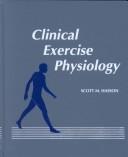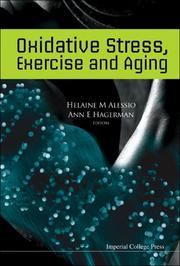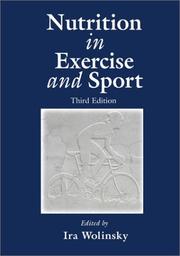| Listing 1 - 10 of 231 | << page >> |
Sort by
|

ISBN: 0815142102 Year: 1994 Publisher: Saint Louis Mosby
Abstract | Keywords | Export | Availability | Bookmark
 Loading...
Loading...Choose an application
- Reference Manager
- EndNote
- RefWorks (Direct export to RefWorks)
Book
ISBN: 1839699523 Year: 2022 Publisher: London : IntechOpen,
Abstract | Keywords | Export | Availability | Bookmark
 Loading...
Loading...Choose an application
- Reference Manager
- EndNote
- RefWorks (Direct export to RefWorks)
Exercise physiology is one of the most researched sports sciences, with practical implications for health, well-being and sports performance. This book brings together emerging research in this area, presenting the main findings and criticisms, as well as considering the future of exercise physiology.
Exercise --- Physiological aspects. --- Exercise physiology --- Clinical exercise physiology --- Physiological effect
Book
Year: 2016 Publisher: Champaign, IL : Human Kinetics,
Abstract | Keywords | Export | Availability | Bookmark
 Loading...
Loading...Choose an application
- Reference Manager
- EndNote
- RefWorks (Direct export to RefWorks)
Exercise science practitioners have access to mountains of research findings, expert opinions, novel techniques, and program plans via blogs, fitness magazines, conference presentations, and peer-reviewed journals. To facilitate effective practice, practitioners must sift through this information and retain only the best evidence to form a sound base of knowledge. Evidence-Based Practice in Exercise Science: The Six-Step Approach equips readers with the basic skills and competencies for discerning the value of scientific research. Using a methodical approach, students and professionals will learn to identify appropriate evidence to support novel interventions and avoid counterproductive or dangerous information to eliminate ineffective exercise options. The authors, well-known advocates in the study and application of evidence-based practice in the field of exercise science, take the five-step method of evidence-based practice that has been established in medicine, adapt it specifically for exercise science, and expand it to embrace individuality in exercise training. The content is accessible for students in a variety of courses in exercise science curricula; those seeking certification through professional organizations; and practitioners in the fields of exercise, nutrition, sports medicine, and sport science. This text is an instruction manual in understanding and applying evidence-based practice. The process is divided into six steps that begin with asking a question and then finding, evaluating, implementing, confirming, and re-evaluating the evidence. Readers of Evidence-Based Practice in Exercise Science will explore these aspects: The philosophy of science and design of scientific studies; The use of search tools like PubMed and Google Scholar and how to rank or define the strength of the evidence; Practical suggestions for implementing evidence-based practice in the field to better advise and serve athletes, clients, and patients; Case studies that demonstrate realistic scenarios of how the evidence-based process may be used in a variety of sport and exercise settings. Each chapter opens with chapter objectives that provide a road map for learning, and a chapter conclusion summarizes main points and ensures understanding. The case studies cover topics including exercise prescription; exercise for special populations; nutrition and supplementation; and exercise devices, equipment, and apparel. Each case presents a realistic scenario that an exercise practitioner may experience, presents background information, formulates a question for investigation, describes a search of the literature, discusses the findings, and provides a recommendation for practice based on the best current evidence. Evidence-Based Practice in Exercise Science is grouped into four sections that assist readers in gaining a better understanding of the evidence-based practice paradigm, learning the step-by-step method, and acquiring experience in the evidence-based approach by working through practical examples using real-world scenarios. Part I offers foundational knowledge of evidence-based practice in exercise sciences. Part II introduces the six-step method of evidence-based practice with chapters that explore each step of the process in depth. Part III presents 16 case studies grouped into chapters by general topics. Part IV concludes the text with chapters on disseminating and sharing knowledge and the future of evidence-based practice in exercise science. By understanding the concepts and process of evidence-based practice, current and future sport, exercise, and health professionals will prescribe individualized programs and treatments that improve athletic performance and lead individuals toward better health. Embracing evidence-based practice will ultimately advance the field and produce optimal outcomes for clients, patients, and athletes.
Sports medicine. --- Clinical exercise physiology. --- Evidence-based medicine.
Book
ISBN: 9781492546450 1492546453 Year: 2019 Publisher: Champaign, IL : Human Kinetics,
Abstract | Keywords | Export | Availability | Bookmark
 Loading...
Loading...Choose an application
- Reference Manager
- EndNote
- RefWorks (Direct export to RefWorks)
As the profession of clinical exercise physiology continues to evolve, there is one cornerstone text that evolves along with it. Clinical Exercise Physiology, Fourth Edition With Web Resource, has been a mainstay in the field since its inception in 2003, and the revisions and additions to this latest rendition reinforce its elite status.As the most comprehensive resource available, Clinical Exercise Physiology, Fourth Edition, provides greater coverage and depth of diseases than is typically found in most clinical exercise physiology textbooks. It thoroughly examines the effects of exercise on chronic disease and then investigates 24 chronic conditions, covering the scope of each disease as well as the pathophysiology, medications, and clinical applications. It also examines clinical considerations and exercise prescriptions for four special populations.This fourth edition reflects the latest American College of Sports Medicine (ACSM) standards and guidelines, making it an ideal resource for candidates preparing for ACSM Clinical Exercise Physiologist certification. In addition to updated content that aligns with current science and evidence-based practice guidelines, the fourth edition also incorporates the following:• A closer and more up-to-date look at the state of the profession• A new web resource featuring case studies that depict real-life scenarios• A new chapter on Parkinson’s disease• Enhanced coverage of exercise testing and exercise prescription, in separate chapters to delve deeper into each of those topics• An expanded chapter on end-stage renal disease, to more broadly cover chronic kidney disease• Significant revisions to chapters on metabolic syndrome, diabetes, and heart failureThe online case studies are written in the form of SOAP (Subjective, Objective, Assessment, Plan) notes, reflecting common medical chart documentation, to help readers experience realistic examples. The text also offers Practical Application sidebars in each chapter; some of these sidebars focus on exercise prescription, and other Practical Application sidebars review the relevant literature related to physiological adaptations to exercise training. To aid in course preparation, instructors are provided a test package, chapter quizzes, and a presentation package plus image bank.Clinical Exercise Physiology, Fourth Edition, offers a contemporary review of the variety of diseases and conditions that students and professionals may encounter in the field. New and veteran clinical exercise physiologists alike, as well as those preparing for ACSM certification exams, will appreciate the in-depth coverage of the clinical populations that benefit from physical activity and exercise.
Exercise therapy. --- Clinical exercise physiology. --- Exercise Therapy. --- Exercise --- Exercise Movement Techniques. --- physiology.
Book
ISBN: 0128206829 9780128209370 0128209372 9780128206829 Year: 2021 Publisher: Waltham : Elsevier,
Abstract | Keywords | Export | Availability | Bookmark
 Loading...
Loading...Choose an application
- Reference Manager
- EndNote
- RefWorks (Direct export to RefWorks)
"Thoroughly examines fundamental concepts in exercise and sports epigenetics, methods for new research, and known impacts for human physiology, disease, and clinical outcomes Discusses exercise and sports epigenetics in relation to metabolism, obesity, aging, immunity, and neurological disease, concussion, and sports doping, among other topics Includes preliminary information on exercise epigenetics and covid-19 infection Features chapter contributions from international experts in the field"--
Exercise --- Epigenetics. --- Epigenomics. --- Physiological aspects. --- Epigenetics --- Epigenetic --- Epigenomic --- Genetics --- Exercise physiology --- Clinical exercise physiology --- Physiological effect
Book
ISBN: 9783030943059 Year: 2022 Publisher: Cham Springer International Publishing :Imprint: Springer
Abstract | Keywords | Export | Availability | Bookmark
 Loading...
Loading...Choose an application
- Reference Manager
- EndNote
- RefWorks (Direct export to RefWorks)
Energy metabolism. --- Exercise --- Physiological aspects. --- Exercise physiology --- Clinical exercise physiology --- Bioenergetics --- Metabolism --- Microbial respiration --- Physiological effect

ISBN: 1281867225 9786611867225 1860949126 9781860949128 9781281867223 1860946194 9781860946196 9781860949128 Year: 2006 Publisher: London Hackensack, NJ Imperial College Press Distributed by World Scientific Pub.
Abstract | Keywords | Export | Availability | Bookmark
 Loading...
Loading...Choose an application
- Reference Manager
- EndNote
- RefWorks (Direct export to RefWorks)
This book brings together some of the leading researchers in the actively investigated field of oxidative stress, an area of study which is of importance to human health and disease. It examines oxidative stress in a variety of models, at rest and after exercise, in young and old. Key concepts of oxidative stress, exercise and aging are presented in clear and easy-to-understand terms. Oxidative stress in different types of exercises - isometric, isotonic and sports - is explained in detail, with several chapters focusing on acute and chronic adaptations of skeletal muscles following both aerobic and non-aerobic exercises. The book includes current knowledge of the underlying mechanisms influencing health and disease processes associated with oxidative stress.
Oxidative stress. --- Exercise --- Aging --- Exercise physiology --- Clinical exercise physiology --- Oxidation-reduction reaction --- Stress (Physiology) --- Physiological aspects. --- Physiological effect

ISBN: 0849385601 Year: 2002 Publisher: Boca Raton, FL : CRC Press [Chemical Rubber Company],
Abstract | Keywords | Export | Availability | Bookmark
 Loading...
Loading...Choose an application
- Reference Manager
- EndNote
- RefWorks (Direct export to RefWorks)
Athletes --- Exercise --- Sportifs --- Exercice --- Nutrition. --- Physiological aspects. --- Alimentation --- Aspect physiologique --- Sport en voeding --- Nutrition --- Physiological aspects --- Exercise physiology --- Clinical exercise physiology --- Physiological effect
Book
ISBN: 0128096918 0128092068 9780128096918 9780128092064 9780128092064 Year: 2016 Publisher: Amsterdam
Abstract | Keywords | Export | Availability | Bookmark
 Loading...
Loading...Choose an application
- Reference Manager
- EndNote
- RefWorks (Direct export to RefWorks)
This book provides an overview of the biochemistry of exercise, sport, and physical activity -- from key traditional concepts and recent findings to developing trends in analytical chemistry that will inform future research and application.
Sports --- Exercise --- Energy metabolism. --- Physiological aspects. --- Bioenergetics --- Metabolism --- Microbial respiration --- Exercise physiology --- Clinical exercise physiology --- Athletics --- Sports physiology --- Sports sciences --- Physiological effect --- Physiological aspects
Book
ISBN: 0128145943 0128145935 9780128145944 9780128145937 Year: 2019 Publisher: London, United Kingdom
Abstract | Keywords | Export | Availability | Bookmark
 Loading...
Loading...Choose an application
- Reference Manager
- EndNote
- RefWorks (Direct export to RefWorks)
Muscles --- Exercise --- physiology --- Physiological aspects. --- Pathophysiology. --- Muscle --- Musculature --- Myodynamics --- Myology --- Musculoskeletal system --- Tissues --- Exercise physiology --- Clinical exercise physiology --- Muscle Tissue --- Muscle Tissues --- Tissue, Muscle --- Tissues, Muscle --- Physiological effect
| Listing 1 - 10 of 231 | << page >> |
Sort by
|

 Search
Search Feedback
Feedback About UniCat
About UniCat  Help
Help News
News